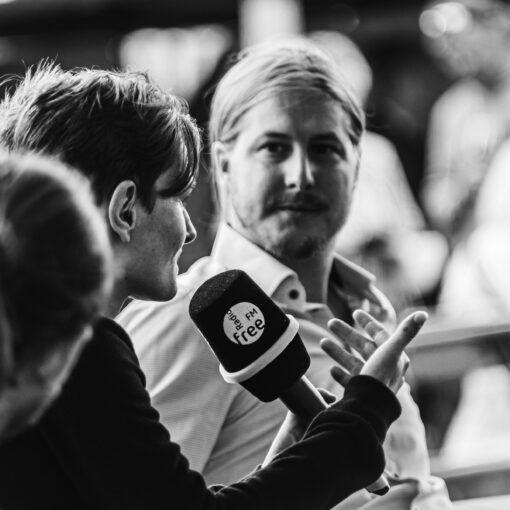Talking with Tamás Jamriskó, Editor-in-Chief of the small community radio EPER (Első Pesti Egyetemi Rádió) – the first university radio of the city of Pest in Hungary, the question is challenging, but easy: a child of the 90s he realized that the ‘community radio’ that the older generation of the 80s and 90s has venerated, focusing on the ‘community’ of producers, the togetherness, the solidarity and the shared social action agenda is, indeed, crumbling, in the pressured press freedom reality in Hungary.“ With a state radio focusing on ‘Hungary, family and religion’ – and with no public service media at all, a minimal commercial media sector, and with a community and alternative media sector being, uhm… individualized, there is not much in Hungary in terms of a ‘normal’ European media landscape with the three tiers of public service; commercial; and community/alternative broadcasting,” Tamás says. “In Eastern Europe many of the formats we inherited from the West are slowly disappearing!”
A 200-page application needed for a 1km radius licence
In this environment, EPER radio had to prepare – with paid assistance – a 200 pages application to get a license. It took 4 weeks (and Tamás started smoking again!) but they got their license, and with it around €11.000 per year in state support. This amount pays the station’s editor, the coordinators, and some freelance inputs. The rest of the work done in EPER radio is volunteer work. Besides from the 200-page complex application, Tamás stresses that EPER radio is not considered a threat by the authorities – as Civil Radio was – and that this is definitely also a reason why they were granted a license. He finds it rather absurd to go through all of that and then just get a license for broadcasting a 1 km radius. But they are ‘legal’ and do fill up the flow channel 24/7. But the real focus is on their internet platform, where the state does not control them. Here they have the freedom they want. Freedom of voices, of expression, sharing their content-rich programmes.
The National Community Radio Association turns 30, with membership dwindling
Tamás, himself, has worked for some years with Civil Radio in Budapest, and is friendly with Tilós Radio, Club Radio and others of the more than 20 strong ‘freedom of expression’ radios of the 90s. But things are changing. The pandemic has increased the pace, but also without that, there are only 5-6 community radios left in Hungary, as the ‘Hungarian Free Community Radio Association’ is planning to celebrate its 30 years’ anniversary later this spring.
Radio EPER leaves the collective social change agenda, focusing on creator-audience relation
Tamás tells that EPER radio is less focused on a shared social development and change agenda brought forward by a collective, than of the close relation between the producer and her/his audience. The community radio becomes more of a platform for individual creators who develop their relationship with each of their groups of specific audiences. EPER radio has a passive group of some 90 to 100 producers, of which 15-20 are active. They broadcast 24/7 both on a license allowing them to cover a 1 km radius only AND online, where they have a lot more special-interest listeners. For instance, they have a podcast on archaeology where they have registered listeners to be men between the ages of 30 to 50, and one covering the new movies, where the core listener is a woman between 18 to 24.
Tamas does not see a future for old-school community radio in Hungary, rather, he believes micro-communities are the answer!
Based on Tamás’ experience in the Budapest-based Civil radio, he has attempted to create more of a ‘collective’ around the station. He invited all the broadcasters/creators to an editorial meeting, but it was not a success. The interest of the creators is much more individualized: they have their group of audiences in mind and not the station, which simply becomes the platform from which they broadcast. Whereas the editorial meeting and Tamás’ attempt to create more of a collective spirit in the radio station did not work, his invite for a garden party at his place was a success – a lot of the producers appeared, and they had a lovely time.
‘Corona Chronicle’ and ‘Get The Trolls Out’ brought the station together
During the pandemic, the station successfully produced a bi-weekly ‘Corona Chronicle’, where 15-20 creators sent stories to the station every 2-3 days: small human-based stories, which partly shared crucial Corona-related information, partly shared how others were coping – or not – during the pandemic. This saw a higher level of cooperation, which now, when things are slowly normalising, has ceased to exist. Radio EPER furthermore collaborates with other community radios / media in Europe. Among others the radio is one of the CMFE partner radios in the project Get the Trolls Out! where they tackle issues of disinformation, hate speech and anti-religious discrimination. You can find the first EPER production here. https://getthetrollsout.org/cmfe-articles/on-framing-and-not-caring-about-elephants-a-broadcast-and-podcast-by-eper-radio?utm_source=newsletter&utm_medium=email&utm_campaign=radio_and_trust_but_what_if_you_dont_trust_your_local_radio&utm_term=2022-06-29
While the 20th Century was the century of Radio, the 21st century is the podcast era, Tamás concludes
Looking into the future, Tamás is convinced that the earlier community radio ‘unity’ will not return. His realistic vision onwards is that the future of community radio – at least in Hungary and neighbouring former Eastern European countries, as he says, will be that of shared platforms made up by micro communities. These ‘communities’ will consist solely of the creator and her/his audience: voice and content-based. The 21st century is the podcast era, Tamás says.
This text is from the CMFE Newsletter (https://preview.mailerlite.com/i9b9t7y2x7/1893387367314626043/p0s9/) from February 2022. It’s written by Birgitte Jallov.




